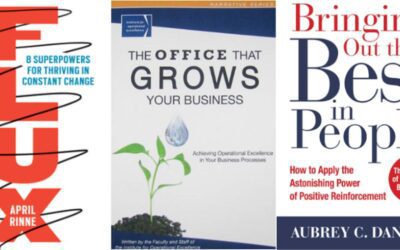Results matter
Just ask any olympic athlete about the importance of results .025 seconds can mean the difference between a bronze medal or none at all.
What do you do as a business when you’re not getting the results you want? What if you’re not profitable enough? What if your marketing plan is collecting dust on the shelf? What if your quality is still not as consistent as you’d like? When our businesses don’t meet our expectations it can be disappointing, or even crippling.
Why do our businesses fail to meet expectations?
Enter Aubrey Daniels, leadership guru and business strategy extraordinaire.
Our processes, businesses, and lives are perfectly designed to deliver the results that they are delivering. Both good and bad.
What does Aubrey mean by “perfectly designed”? Many business owners would say they didn’t design their companies to deliver mediocre levels of cost, quality or delivery they are now experiencing! I’m suggesting that whether you are a business owner, process manager, or engineer you are only partially responsible for the design of your business.
Your processes are designed by the collective will of your culture rather than the conscious will of any one or few members of the culture.
Culture simply is the collection of shared rituals, stories, practices and actions that its members participate in every day.
Dan Miller gave OMEP this definition as part of our “Tools for Conscious Leadership” series.
In other words, culture is reflected in the behaviors of its members and results come directly from those same behaviors. Both culture and results are outcomes, not inputs, and both are driven by behaviors.
If you want to change your company, focus on changing behaviors. You will start to move the results you are generating as well as your culture. Here’s how I think about this process of change based on my experience with manufacturers. This thinking is influenced by the work of people smarter than me, including Aubrey Daniels’ “Bringing out the Best in People” and Mike Rother’s Toyota Kata.
The Process of Change
- What are the “observable and measurable” results you are looking for? Be objective, don’t use subjective or opinion based language. Also, stay away from language of blame, fault and judgment.
- What results are you getting now?
- What results do you want to get?
- How big is the gap? (I’m not looking for cause or solution yet, just a statement of gap)
- Identify the specific, observable behaviors related to:
- Behaviors that lead to desired results
- That impede desired results
- That lead to undesired results
- Have you communicated the right, measurable, observable expectations? Have you communicated them well using a variety of methods (verbal, written, visual)? Do you have multiple conflicting or difficult to reconcile expectations?
- What kinds of positive and negative consequences are influencing the desired and undesired behaviors. Not all consequences come from management; what consequences come from the peer culture or are natural from the environment? You may not be able to control all the consequences, but it’s the sum of the consequences, both positive and negative, that drive behaviors.
- What kind of leadership behaviors are present (and absent) from the organization? A leader’s ability to be present, demonstrate empathy, set clear expectations, provide support and hold people accountable is crucial to how the people doing the work engage in various behaviors.
Most of the results that matter to us depend on how people engage with their work. That is, their behaviors. We as owners, leaders, engineers, and associates need to remember that how we show up drives the results that make or break our organizations.



